warranted or necessary to me.
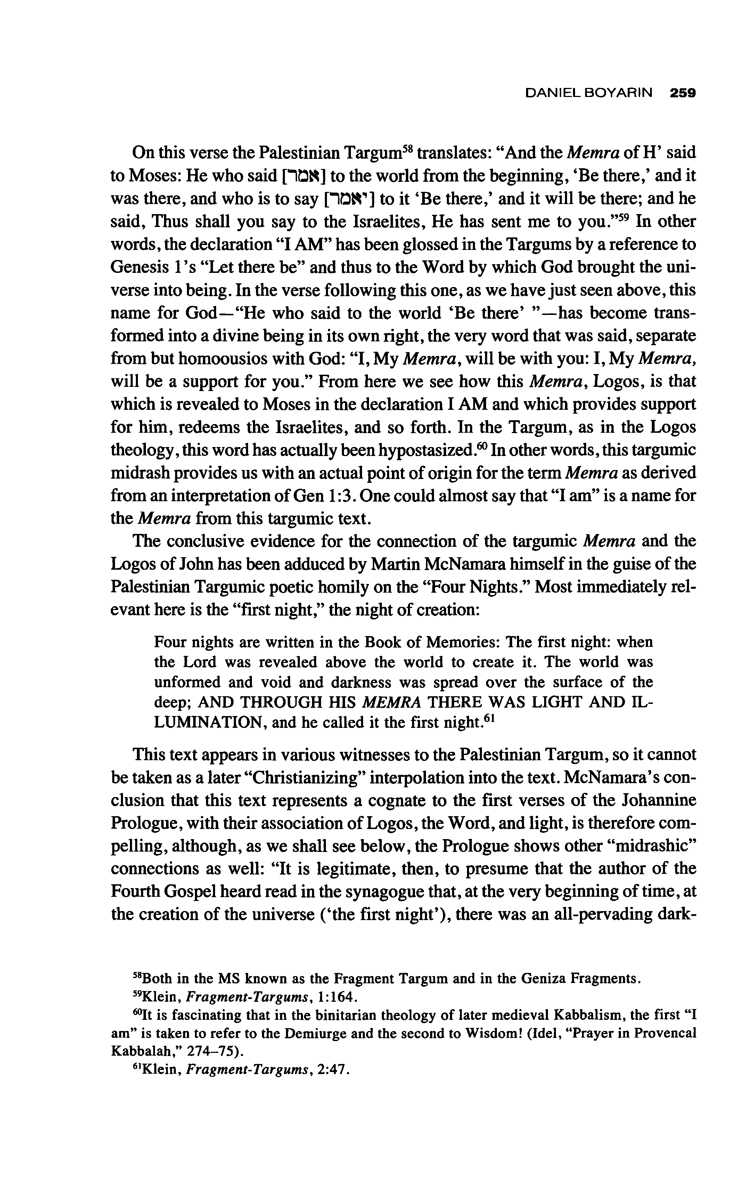
D A N I EL BOYAR ΙΝ 2 5 9
On this verse the Palestinian Targum58 translates: "And the Memra of H' said
to Moses: He who said pÛN] to the world from the beginning, 4Be there,' and it
was there, and who is to say püK''] to it 'Be there,' and it will be there; and he
said, Thus shall you say to the Israelites, He has sent me to you."59 In other
words, the declaration "I AM" has been glossed in the Targums by a reference to
Genesis 1 's "Let there be" and thus to the Word by which God brought the uni-
verse into being. In the verse following this one, as we have just seen above, this
name for God—"He who said to the world 'Be there' "—has become trans-
formed into a divine being in its own right, the very word that was said, separate
from but homoousios with God: "I, My Memra, will be with you: I, My Memra,
will be a support for you." From here we see how this Memra, Logos, is that
which is revealed to Moses in the declaration I AM and which provides support
for him, redeems the Israelites, and so forth. In the Targum, as in the Logos
theology, this word has actually been hypostasized.60 In other words, this targumic
midrash provides us with an actual point of origin for the term Memra as derived
from an interpretation of Gen 1:3. One could almost say that "I am" is a name for
the Memra from this targumic text.
The conclusive evidence for the connection of the targumic Memra and the
Logos of John has been adduced by Martin McNamara himself in the guise of the
Palestinian Targumic poetic homily on the "Four Nights." Most immediately rel-
evant here is the "first night," the night of creation:
Four nights are written in the Book of Memories: The first night: when
the Lord was revealed above the world to create it. The world was
unformed and void and darkness was spread over the surface of the
deep; AND THROUGH HIS MEMRA THERE WAS LIGHT AND IL-
LUMINATION, and he called it the first night.61
This text appears in various witnesses to the Palestinian Targum, so it cannot
be taken as a later "Christianizing" interpolation into the text. McNamara's con-
clusion that this text represents a cognate to the first verses of the Johannine
Prologue, with their association of Logos, the Word, and light, is therefore com-
pelling, although, as we shall see below, the Prologue shows other "midrashic"
connections as well: "It is legitimate, then, to presume that the author of the
Fourth Gospel heard read in the synagogue that, at the very beginning of time, at
the creation of the universe ('the first night'), there was an all-pervading dark-
58Both in the MS known as the Fragment Targum and in the Geniza Fragments.
59Klein, Fragment-Targums, 1:164.
^It is fascinating that in the binitarian theology of later medieval Kabbalism, the first "I
am" is taken to refer to the Demiurge and the second to Wisdom! (Idei, "Prayer in Provencal
Kabbalah," 274-75).
6,Klein, Fragment-Tar gums, 2:47.
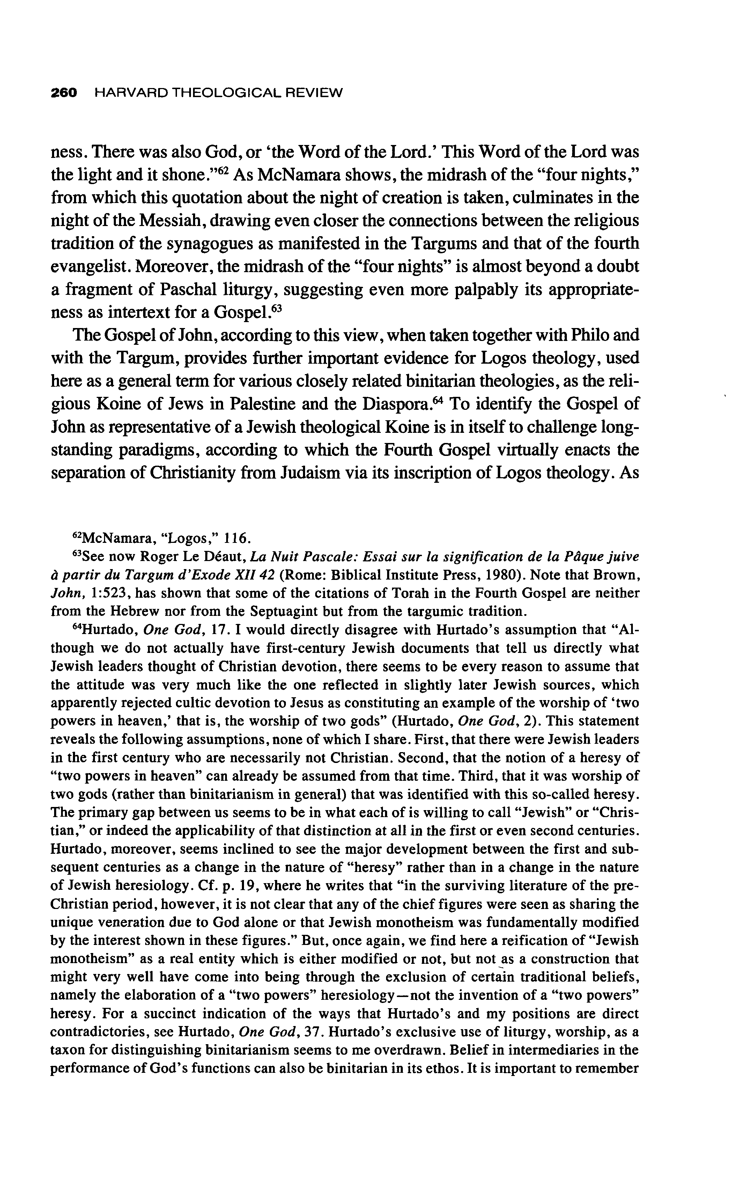
2 6 0 H A R V A R D T H E O L O G I C A L REVIEW
ness. There was also God, or 'the Word of the Lord.' This Word of the Lord was
the light and it shone."62 As McNamara shows, the midrash of the "four nights,"
from which this quotation about the night of creation is taken, culminates in the
night of the Messiah, drawing even closer the connections between the religious
tradition of the synagogues as manifested in the Targums and that of the fourth
evangelist. Moreover, the midrash of the "four nights" is almost beyond a doubt
a fragment of Paschal liturgy, suggesting even more palpably its appropriate-
ness as intertext for a Gospel.63
The Gospel of John, according to this view, when taken together with Philo and
with the Targum, provides further important evidence for Logos theology, used
here as a general term for various closely related binitarian theologies, as the reli-
gious Koine of Jews in Palestine and the Diaspora.64 To identify the Gospel of
John as representative of a Jewish theological Koine is in itself to challenge long-
standing paradigms, according to which the Fourth Gospel virtually enacts the
separation of Christianity from Judaism via its inscription of Logos theology. As
62McNamara, "Logos," 116.
63See now Roger Le Déaut, La Nuit Pascale: Essai sur la signification de la Pâque juive
à partir du Targum d'Exode XII42 (Rome: Biblical Institute Press, 1980). Note that Brown,
John, 1:523, has shown that some of the citations of Torah in the Fourth Gospel are neither
from the Hebrew nor from the Septuagint but from the targumic tradition.
64Hurtado, One God, 17. I would directly disagree with Hurtado's assumption that "Al-
though we do not actually have first-century Jewish documents that tell us directly what
Jewish leaders thought of Christian devotion, there seems to be every reason to assume that
the attitude was very much like the one reflected in slightly later Jewish sources, which
apparently rejected cultic devotion to Jesus as constituting an example of the worship of 'two
powers in heaven,' that is, the worship of two gods" (Hurtado, One God, 2). This statement reveals the following assumptions, none of which I share. First, that there were Jewish leaders
in the first century who are necessarily not Christian. Second, that the notion of a heresy of
"two powers in heaven" can already be assumed from that time. Third, that it was worship of
two gods (rather than binitarianism in general) that was identified with this so-called heresy.
The primary gap between us seems to be in what each of is willing to call "Jewish" or "Chris-
tian," or indeed the applicability of that distinction at all in the first or even second centuries.
Hurtado, moreover, seems inclined to see the major development between the first and sub-
sequent centuries as a change in the nature of "heresy" rather than in a change in the nature
of Jewish heresiology. Cf. p. 19, where he writes that "in the surviving literature of the pre-
Christian period, however, it is not clear that any of the chief figures were seen as sharing the
unique veneration due to God alone or that Jewish monotheism was fundamentally modified
by the interest shown in these figures." But, once again, we find here a reification of "Jewish
monotheism" as a real entity which is either modified or not, but not as a construction that
might very well have come into being through the exclusion of certain traditional beliefs,
namely the elaboration of a "two powers" heresiology—not the invention of a "two powers"
heresy. For a succinct indication of the ways that Hurtado's and my positions are direct
contradictories, see Hurtado, One God, 37. Hurtado's exclusive use of liturgy, worship, as a
taxon for distinguishing binitarianism seems to me overdrawn. Belief in intermediaries in the
performance of God's functions can also be binitarian in its ethos. It is important to remember
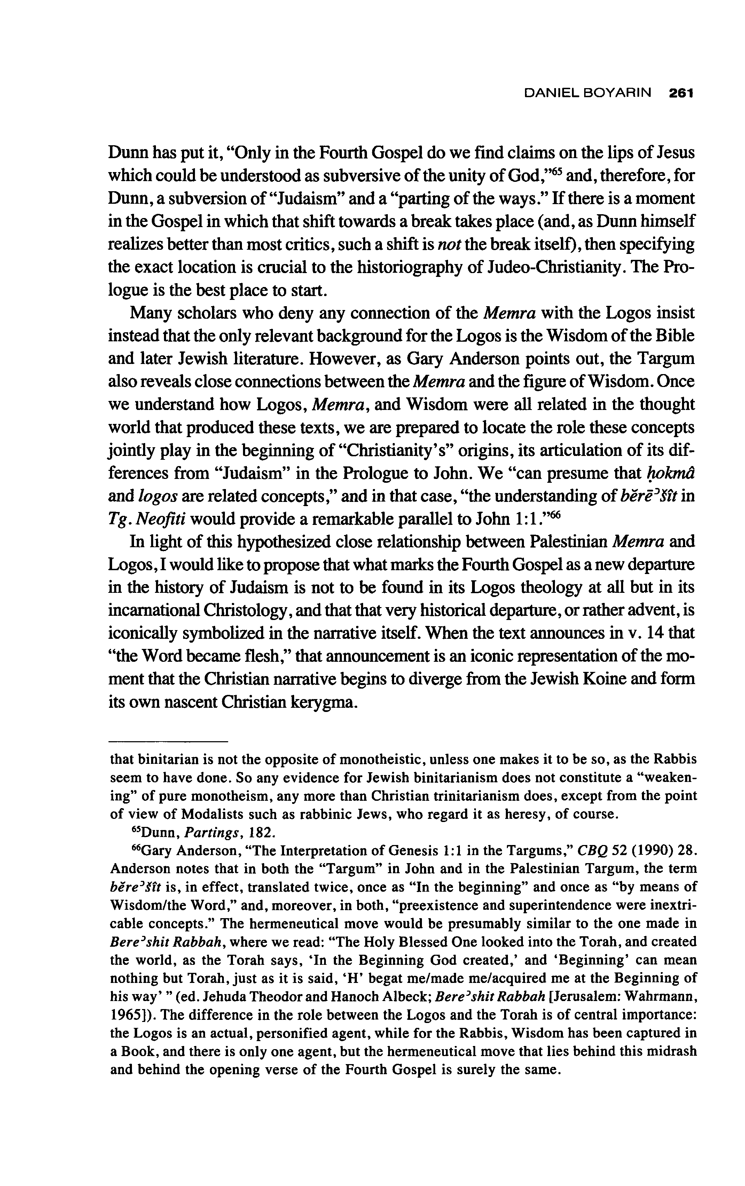
DANIEL BOYARÍN 2 6 1
Dunn has put it, "Only in the Fourth Gospel do we find claims on the lips of Jesus
which could be understood as subversive of the unity of God,"65 and, therefore, for
Dunn, a subversion of "Judaism" and a "parting of the ways." If there is a moment
in the Gospel in which that shift towards a break takes place (and, as Dunn himself
realizes better than most critics, such a shift is not the break itself), then specifying
the exact location is crucial to the historiography of Judeo-Christianity. The Pro-
logue is the best place to start.
Many scholars who deny any connection of the Memra with the Logos insist
instead that the only relevant background for the Logos is the Wisdom of the Bible
and later Jewish literature. However, as Gary Anderson points out, the Targum
also reveals close connections between the Memra and the figure of Wisdom. Once
we understand how Logos, Memra, and Wisdom were all related in the thought
world that produced these texts, we are prepared to locate the role these concepts
jointly play in the beginning of "Christianity's" origins, its articulation of its dif-
ferences from "Judaism" in the Prologue to John. We "can presume that hokma
and logos are related concepts," and in that case, "the understanding of bêrëD$ît in
Tg. Neofiti would provide a remarkable parallel to John 1:1 ,"66
In light of this hypothesized close relationship between Palestinian Memra and
Logos, I would like to propose that what marks the Fourth Gospel as a new departure
in the history of Judaism is not to be found in its Logos theology at all but in its
incarnational Christology, and that that very historical departure, or rather advent, is
iconically symbolized in the narrative itself. When the text announces in v. 14 that
"the Word became flesh," that announcement is an iconic representation of the mo-
ment that the Christian narrative begins to diverge from the Jewish Koine and form
its own nascent Christian kerygma.
that binitarian is not the opposite of monotheistic, unless one makes it to be so, as the Rabbis
seem to have done. So any evidence for Jewish binitarianism does not constitute a "weaken-
ing" of pure monotheism, any more than Christian trinitarianism does, except from the point
of view of Modalists such as rabbinic Jews, who regard it as heresy, of course.
65Dunn, Partings, 182.
66Gary Anderson, "The Interpretation of Genesis 1:1 in the Targums," CBQ 52 (1990) 28.
Anderson notes that in both the "Targum" in John and in the Palestinian Targum, the term
bere3Sit is, in effect, translated twice, once as "In the beginning" and once as "by means of Wisdom/the Word," and, moreover, in both, "préexistence and superintendence were inextri-cable concepts." The hermeneutical move would be presumably similar to the one made in
BereDshit Rabbah, where we read: "The Holy Blessed One looked into the Torah, and created
the world, as the Torah says, 'In the Beginning God created,' and 'Beginning' can mean
nothing but Torah, just as it is said, Ή ' begat me/made me/acquired me at the Beginning of
his way' " (ed. Jehuda Theodor and Hanoch Albeck; Bere3 shit Rabbah [Jerusalem: Wahrmann,
1965]). The difference in the role between the Logos and the Torah is of central importance:
the Logos is an actual, personified agent, while for the Rabbis, Wisdom has been captured in
a Book, and there is only one agent, but the hermeneutical move that lies behind this midrash
and behind the opening verse of the Fourth Gospel is surely the same.
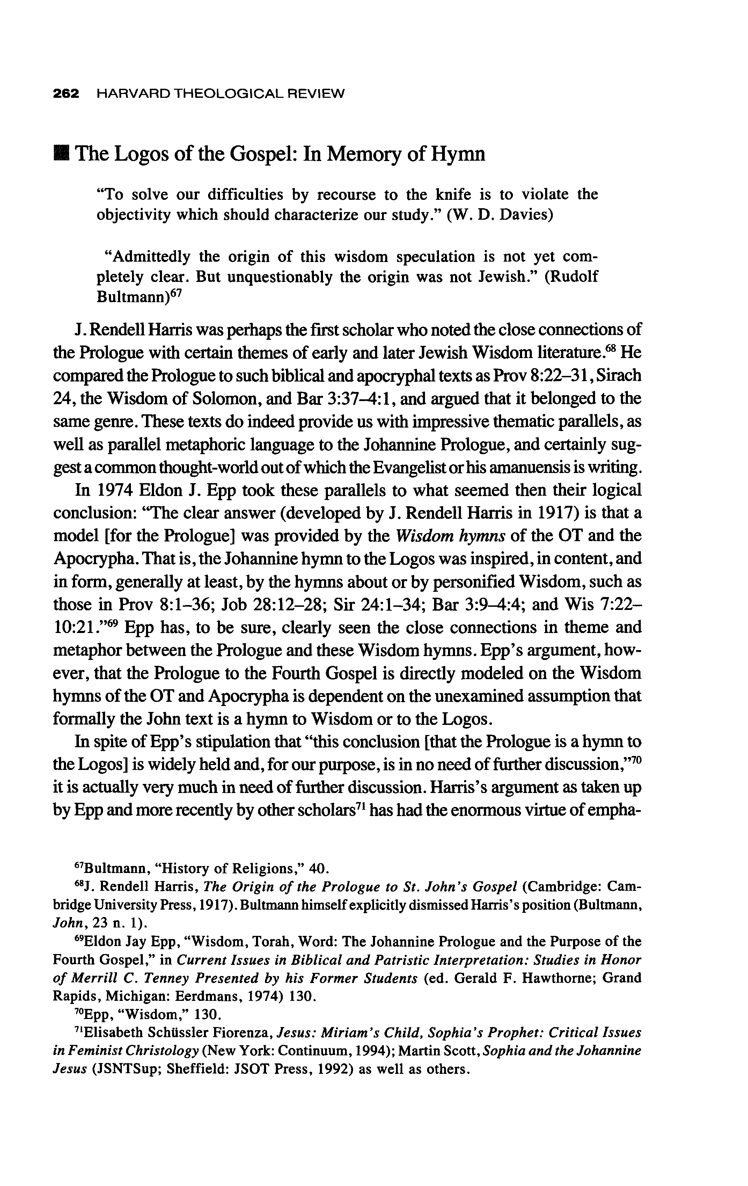
2 6 2 H A R V A R D T H E O L O G I C A L REVIEW
• The Logos of the Gospel: In Memory of Hymn
"To solve our difficulties by recourse to the knife is to violate the
objectivity which should characterize our study." (W. D. Davies)
"Admittedly the origin of this wisdom speculation is not yet com-
pletely clear. But unquestionably the origin was not Jewish." (Rudolf
Bultmann)67
J. Rendell Harris was perhaps the first scholar who noted the close connections of
the Prologue with certain themes of early and later Jewish Wisdom literature.68 He
compared the Prologue to such biblical and apocryphal texts as Prov 8:22-31, Sirach
24, the Wisdom of Solomon, and Bar 3:37-4:1, and argued that it belonged to the
same genre. These texts do indeed provide us with impressive thematic parallels, as
well as parallel metaphoric language to the Johannine Prologue, and certainly sug-
gest a common thought-world out of which the Evangelist or his amanuensis is writing.
In 1974 Eldon J. Epp took these parallels to what seemed then their logical
conclusion: "The clear answer (developed by J. Rendell Harris in 1917) is that a
model [for the Prologue] was provided by the Wisdom hymns of the OT and the
Apocrypha. That is, the Johannine hymn to the Logos was inspired, in content, and
in form, generally at least, by the hymns about or by personified Wisdom, such as
those in Prov 8:1-36; Job 28:12-28; Sir 24:1-34; Bar 3:9^:4; and Wis 7:22-
10:21."69 Epp has, to be sure, clearly seen the close connections in theme and
metaphor between the Prologue and these Wisdom hymns. Epp's argument, how-
ever, that the Prologue to the Fourth Gospel is directly modeled on the Wisdom
hymns of the OT and Apocrypha is dependent on the unexamined assumption that
formally the John text is a hymn to Wisdom or to the Logos.
In spite of Epp's stipulation that "this conclusion [that the Prologue is a hymn to
the Logos] is widely held and, for our purpose, is in no need of further discussion,"70
it is actually very much in need of further discussion. Harris's argument as taken up
by Epp and more recently by other scholars71 has had the enormous virtue of empha-
67Bultmann, "History of Religions," 40.
68J. Rendell Harris, The Origin of the Prologue to St. John's Gospel (Cambridge: Cam-
bridge University Press, 1917). Bultmann himself explicitly dismissed Harris's position (Bultmann,
John, 23 n. 1).
69Eldon Jay Epp, "Wisdom, Torah, Word: The Johannine Prologue and the Purpose of the
Fourth Gospel," in Current Issues in Biblical and Patristic Interpretation: Studies in Honor
of Merrill C. Tenney Presented by his Former Students (ed. Gerald F. Hawthorne; Grand
Rapids, Michigan: Eerdmans, 1974) 130.
70Epp, "Wisdom," 130.
71Elisabeth Schüssler Fiorenza, Jesus: Miriam's Child, Sophia's Prophet: Critical Issues
in Feminist Christology (New York: Continuum, 1994); Martin Scott, Sophia and the Johannine
Jesus (JSNTSup; Sheffield: JSOT Press, 1992) as well as others.
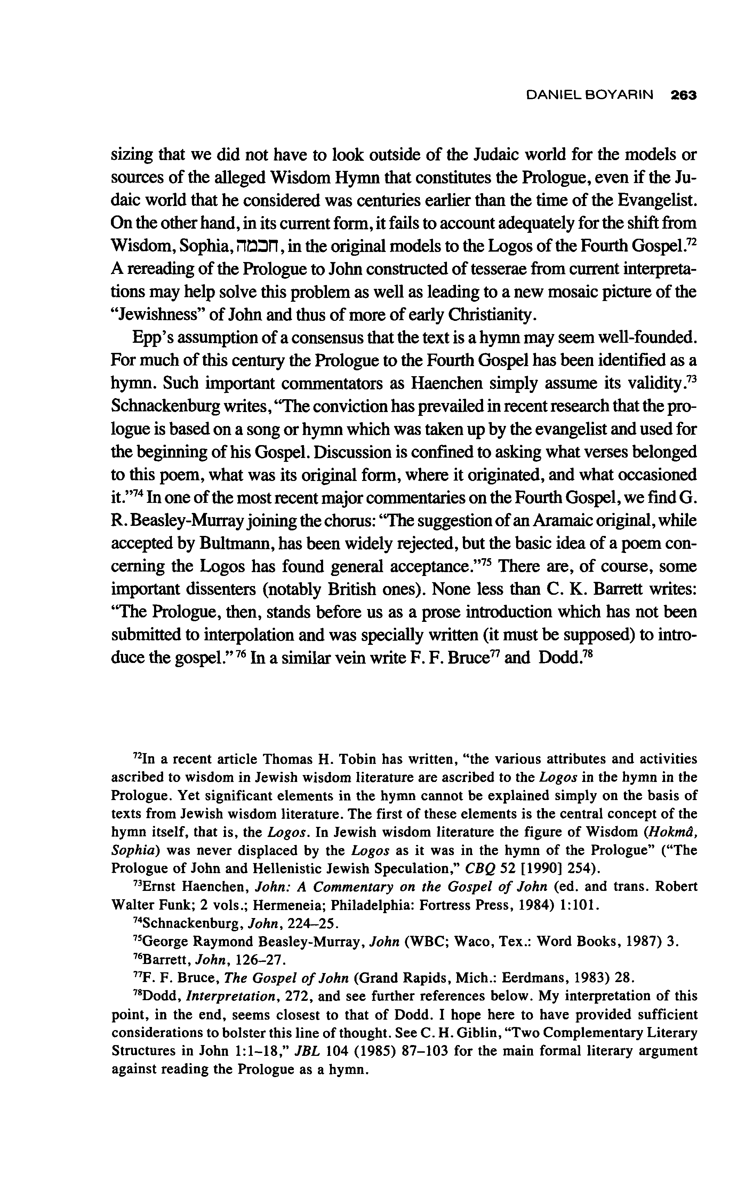
DANIEL B O Y A R Í N 2 6 3
sizing that we did not have to look outside of the Judaic world for the models or
sources of the alleged Wisdom Hymn that constitutes the Prologue, even if the Ju-
daic world that he considered was centuries earlier than the time of the Evangelist.
On the other hand, in its current form, it fails to account adequately for the shift from
Wisdom, Sophia, Π03Π, in the original models to the Logos of the Fourth Gospel.72
A rereading of the Prologue to John constructed of tesserae from current interpretations may help solve this problem as well as leading to a new mosaic picture of the
"Jewishness" of John and thus of more of early Christianity.
Epp's assumption of a consensus that the text is a hymn may seem well-founded.
For much of this century the Prologue to the Fourth Gospel has been identified as a
hymn. Such important commentators as Haenchen simply assume its validity.73
Schnackenburg writes, "The conviction has prevailed in recent research that the prologue is based on a song or hymn which was taken up by the evangelist and used for the beginning of his Gospel. Discussion is confined to asking what verses belonged
to this poem, what was its original form, where it originated, and what occasioned
it."74 In one of the most recent major commentaries on the Fourth Gospel, we find G.
R. Beasley-Murray joining the chorus: "The suggestion of an Aramaic original, while
accepted by Bultmann, has been widely rejected, but the basic idea of a poem concerning the Logos has found general acceptance."75 There are, of course, some important dissenters (notably British ones). None less than C. K. Barrett writes:
"The Prologue, then, stands before us as a prose introduction which has not been
submitted to interpolation and was specially written (it must be supposed) to introduce the gospel."76 In a similar vein write F. F. Bruce77 and Dodd.78
72In a recent article Thomas H. Tobin has written, "the various attributes and activities
ascribed to wisdom in Jewish wisdom literature are ascribed to the Logos in the hymn in the
Prologue. Yet significant elements in the hymn cannot be explained simply on the basis of
texts from Jewish wisdom literature. The first of these elements is the central concept of the
hymn itself, that is, the Logos. In Jewish wisdom literature the figure of Wisdom (Hokmâ,
Sophia) was never displaced by the Logos as it was in the hymn of the Prologue" ("The Prologue of John and Hellenistic Jewish Speculation," CBQ 52 [1990] 254).
73Ernst Haenchen, John: A Commentary on the Gospel of John (ed. and trans. Robert
Walter Funk; 2 vols.; Hermeneia; Philadelphia: Fortress Press, 1984) 1:101.
74Schnackenburg, John, 224-25 .
75George Raymond Beasley-Murray, John (WBC; Waco, Tex.: Word Books, 1987) 3.
76Barrett, John, 126-27.
77F. F. Bruce, The Gospel of John (Grand Rapids, Mich.: Eerdmans, 1983) 28.
78Dodd, Interpretation, 272, and see further references below. My interpretation of this
point, in the end, seems closest to that of Dodd. I hope here to have provided sufficient
considerations to bolster this line of thought. See C. H. Giblin, "Two Complementary Literary
Structures in John 1:1-18," JBL 104 (1985) 87-103 for the main formal literary argument
against reading the Prologue as a hymn.

2 6 4 H A R V A R D T H E O L O G I C A L REVIEW
I will throw my lot in here with the minority.79 What seems to be at stake in this
debate is the question of the Gattung or form of this alleged hymn. It is of impor-
tance in terms of a criticism that locates particular forms in particular living religious
situations. In my view, the Sitz im Leben of the Prologue is a homiletical or preaching
situation, and not one of praise or adoration. It is, moreover, a homiletic retelling
of the beginning of Genesis, and therefore interpretative and narratival in its genre
and not hymnic and cyclical, that is, liturgical.
Acknowledging this point shifts the interpretation of crucial moments in the Pro-
logue itself and reorients our understanding of its place in the literary and theological
scheme of the Gospel as a whole. Since the primary thrust of much, if not most,
interpretation of the Fourth Gospel has been to insist in one way or another that its
Logos theology is uniquely Christian (that is, not Jewish), interpreters taking the
Prologue as a hymn have mostly read it as a hymn to Jesus, that is to the Logos
Incarnate. Even a commentator such as Haenchen, who follows in the tradition of
understanding that the "original" hymn did not incorporate a reference to the Incar-
nate Logos before v. 14, remains convinced that "the redactor did not understand
that the activity of the pre-incarnate Logos was further described in vv. 9-11, but
now made these verses refer to the Logos become flesh, too."80 Haenchen, however,
also reveals the flaw in this interpretation in the very next sentence: "The insertion
does not suit the context: the Logos incarnate, the Galilean Jesus, did not experience
only rejection."81
This general line of interpretation, which can be conveniently found by the
English reader in Raymond Brown's seminal commentary, has led to needless
confusion, unclarity, and "recourse to the knife." In assuming the recursive struc-
tures of the hymn, commentators have been free to assume that the Incarnation is
referred to in the text long before v. 14 with its majestic: "And the Word became
flesh and dwelt among us." Thus an interpreter such as Serafín de Ausejo,82 who
strongly reads the Prologue as belonging to a Christian genre of hymns to Jesus,
reads the entire Prologue as referring to the Logos Ensarkos, a reading that com-
pletely cuts this text off from any Jewish roots whatsoever, and Brown allows that
this interpretation might be correct.83
79See also the discussion in Morna D. Hooker, "John the Baptist and the Johannine Pro-
logue," NTS 16 (1969) 354-58.
80Haenchen, John, 1:128.
81My reading of the Prologue remains, nevertheless, closest in some ways to that of Haenchen,
John, 1:127, who comes closest, I think, as well to the spirit of my proposal for the relation
of the "Jewish" to the new "Christian" kerygma in the text. I hope, however, to obviate
recourse to the knife in order to defend that reading.
82Serafin de Ausejo, "¿Es un himno a Cristo el prólogo de San Juan?" EstBib 15 (1956)
223-77, 381-427.
83Brown, John, 1:23.
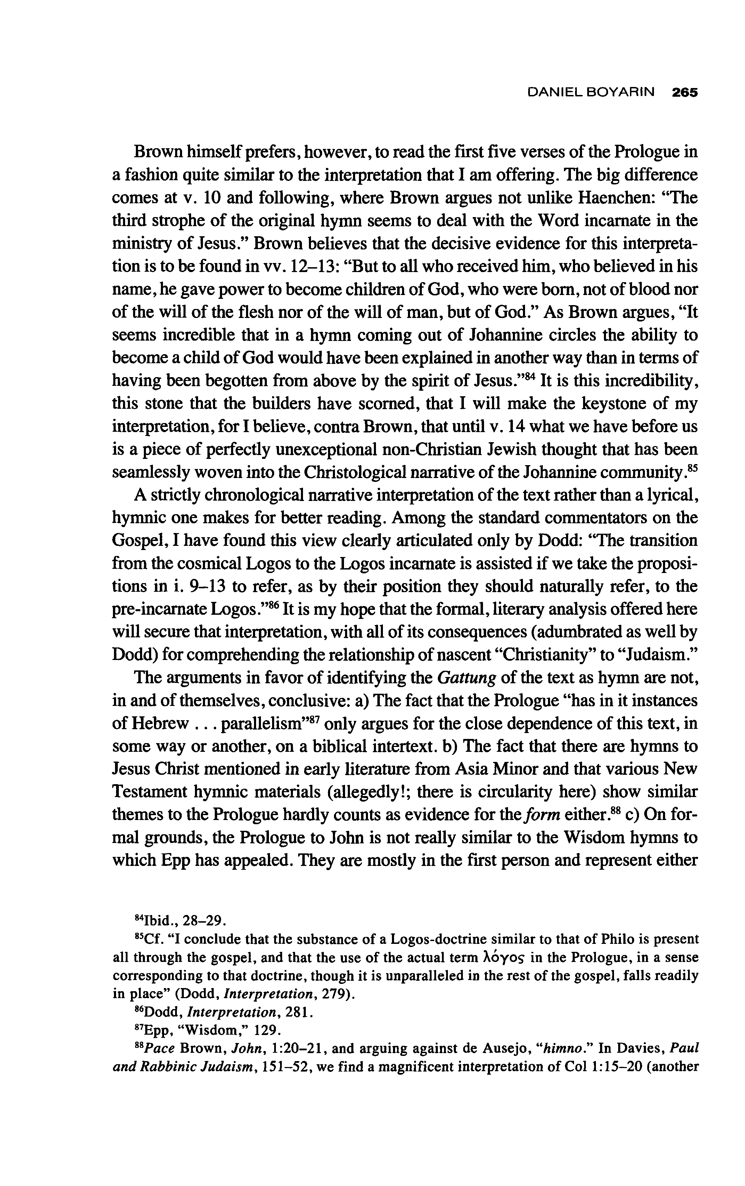
DANIEL B O Y A R Í N 2 6 5
Brown himself prefers, however, to read the first five verses of the Prologue in
a fashion quite similar to the interpretation that I am offering. The big difference
comes at v. 10 and fo










